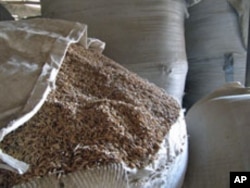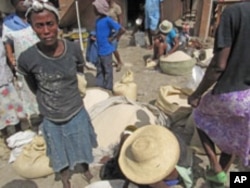About three hours north of Port-au-Prince, the Artibonite Valley is the center of Haiti's rice production.
This season, farmer Charles Surfoad is storing his rice rather than selling it. He says food aid from the earthquake relief effort produced a glut that pushed down prices. If he sells now, he says he'll lose money.
Adverse effects
"Food aid is never good for us," he says. "As a farmer, I'm one of the first affected. You can't send that to a country where that's what they grow."
Surfoad says if he can't sell his rice, he won't have money to buy seeds for next season. And because he supplies about 50 neighbors with seeds, their next season will be affected, too.
The entire supply chain can be affected, from farmers to wholesalers to merchants selling rice in local markets, many of whom say business is down because people are receiving free rice from donors.
Food is one of the most urgent needs in a humanitarian crisis. But, these cases illustrate that when donors bring in food, those who make a living growing and selling food can suffer.
Impact of food aid
"There is a risk, definitely. And we are very aware of that," says Brooke Isham, director of the Food for Peace program at the US Agency for International Development (USAID). "And that is why we are always looking at the impact of food aid on local markets and whether it is depressing prices in local markets."
USAID, the UN World Food Program (WFP) and others monitor markets regularly. Etienne Labonde, head of WFP's program in Haiti, says, as of March, food aid did not cause major disruptions in Haiti's economy. "Maybe it's an impression, but it's not the facts at the moment," he says.
Whether impression or fact, Haitian President Rene Preval raised the issue when he came to Washington last month. He said food aid was indispensible right after the earthquake. But, "If we continue to send food and water from abroad," he said, "it will compete with national production of Haiti and with Haitian trade."
Scaling back
Donors have agreed to scale back. But experts say donors can help the needy and a nation's farmers at the same time if they buy food for humanitarian aid locally rather than importing it.
The European Union, Canada and the World Food Program buy locally when possible. But the United States, which is the largest provider, "is lagging a little bit behind the curve of good practice in food aid," says Marc Cohen with the advocacy group Oxfam.
U.S. food aid consists almost entirely of American grain. Cohen says that started in the 1950s, when the United States had "what were called, 'burdensome surpluses' of food. So, food aid was, first and foremost, a mechanism to get rid of those surpluses," he says.
Congress is considering legislation to allow U.S. food aid to be bought locally.
Meanwhile, in Haiti, many donor agencies are pursuing another strategy to avoid market disruption. They're creating jobs so Haitian people can buy their own food. Many of these jobs are aimed at helping farmers at the same time: improving agricultural canals, rural roads, and planting trees to prevent erosion, for example.
The question now is whether there will be enough jobs so Haitians can support themselves, or whether the country will again face the dilemma of food aid.
















